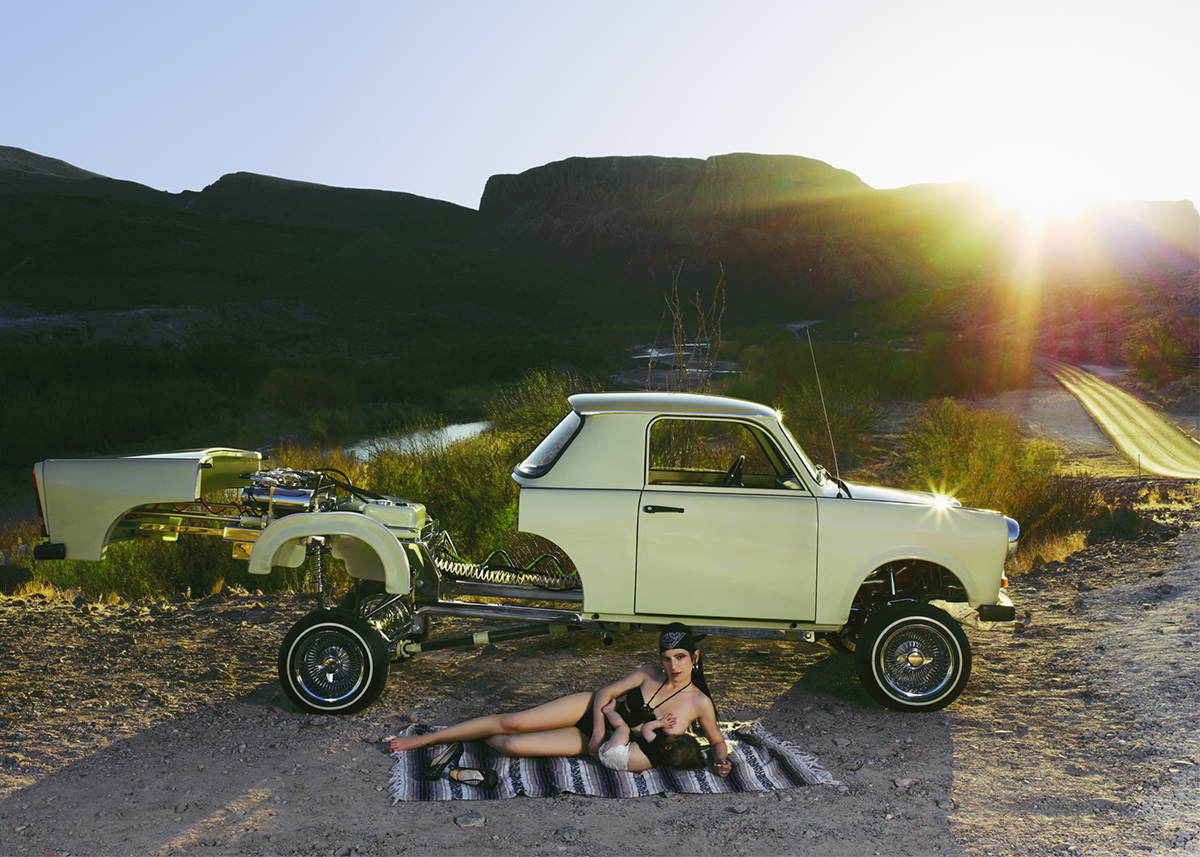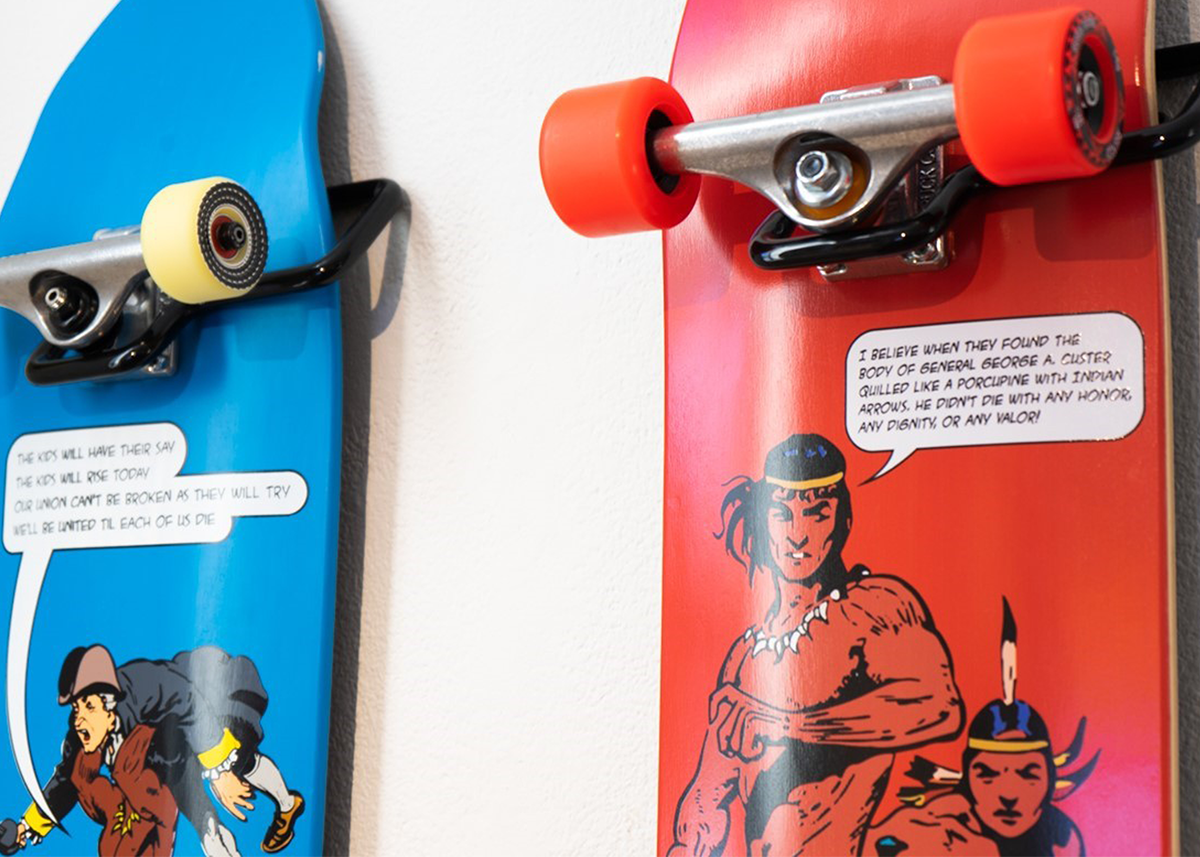
Denver Art Museum

Audio By Carbonatix
The Denver Art Museum is on a roll. The first half of the year saw the museum packed with openings full of creative goodies and diversity, and July welcomed yet another barrier-busting, exceptional exhibit with Desert Rider: Dreaming in Motion, which opened July 9 and will be on display through September 24.
Curated by Victoria I. Lyall, the Jan and Frederick Mayer Curator of Art of the Ancient Americas, Desert Rider is a fresh look at transportation in the West, exploring how some methods can also be forms of expression and empowerment. In particular, the show highlights lowriders, the stylistically dazzling customized cars linked to Mexican-American culture that are often tricked out with gravity-defying hydraulics and candy-color sparkle. Lyall retooled the exhibit, which originated at the Phoenix Art Museum, to include a deep bench of Colorado artists, including Carlos Frésquez, Juan Fuentes, Tony Ortega, Daniel Salazar and Santiago Jaramillo.
They join queer, Latinx, Indigenous and women artists from western and southwestern cultural hot spots in challenging stereotypes about such subcultures as lowriding and skateboarding, including those who are part of them. Artistic mediums run the gamut, and in many cases they are surprisingly combined to lampoon artistic traditions in an approach that’s as satisfying as the sound of polyurethane striking concrete. There are immersive installations, massive photographs of vintage Denver car culture, a wall of boards from Denver skate company 303 Boards and much more.
Greeting visitors is Justin Favela’s large-scale suspended and sparkling lowrider sculpture, Fantasma, which was painstakingly assembled with tissue paper and cardboard to create one most majestic piñata. Favela is a Las Vegas native but a familiar face on the Denver art scene; this piece complements his work already on display in the city, at the David B. Smith Gallery and Denver Botanic Gardens.
This year, make your gift count –
Invest in local news that matters.
Our work is funded by readers like you who make voluntary gifts because they value our work and want to see it continue. Make a contribution today to help us reach our $50,000 goal!
Lowriders are especially significant for Favela. He grew up in a religious environment where representations of car culture were forbidden because of their perceived connotations of violence and criminality. “When I got older, I realized that the way that the media portrays lowriders is not really true…and I realized that the lowrider is one of the most important art forms for the Chicano community,” he says. Favela gained a deep respect for the meticulous craftsmanship of the redesigned vehicles, which often take years to complete.

Daniel Salazar’s “Westside Dreams.”
John Flathman
“The symbol of American progress is the car, and it’s literally moving us through and propelling us forward. … For Latinos to take that symbol and make it their own art form, taking something that’s been discarded, an old car, and turning it into this beautiful sculpture, not only is it just cool to look at; it’s also about family, tradition…religion,” Favela explains. “It’s literally a resurrection.”
Desert Rider presented an opportunity for him to make an especially personal work. “Usually when I make a car, I’m re-creating a car that already exists. This is the first time that a curator asked me to make a car that represents me,” he says.
“I’ve always had this vision of this white lowrider, floating like an angel from above, you know? So when I came up with idea, [I asked myself], ‘How do I queer this up and represent that side of me and Vegas and my Latinx heritage?'” Favela continues. “And this car has all of that.”
Working in white and silver, Favela used the sculpted lowrider’s “paint work” to represent a trio of queer icons: Walter Mercado, Liberace and Juan Gabriel – none of whom came out in their lifetimes. The undercarriage, illuminated in gold, is a nod to the hero of the Club Q shooting, Richard Fierro, who drives a gold lowrider.
Another creative representing queer identity is San Antonio artist José Villalobos, who not only adorned vintage saddles with expressive touches such as pink faux fur and chrome, but also emblazoned them with pejorative homophobic terms. His work, “QueeRiders,” is one of the highlights in the ‘Horsepower’ section, which reconsiders one of the oldest forms of transportation.
“A lot of my work is informed by the border and machismo, and a sense of how we navigate those spaces as queer people,” Villalobos explains. “For me, at least, it was kind of important to start talking about…the lack of representation of queer people in these specific subcultures. I mean, if you really look at everything, the cars are very flamboyant – they’re very sparkly, they’re very gay.” Villalobos links the sense of ownership and machismo involved in crafting a lowrider to the reclamation of the slurs shown in his current installation.
Other artists broadening representation in intriguing ways include Nanibah Chacon and Liz Cohen, as well as Indigenous artists Gregg Deal and Douglas Miles. Chacon and Cohen provide representations of women in what is often the “boys’ club” of lowrider culture, while Deal and Miles lead viewers into discussions about the stolen Native land that lies under a skateboard’s wheels. There’s a lot to take in, but Desert Rider treats its serious subject matter in ways that are both playful and empowering.

Gregg Deal’s “The Punchline Minutemen.”
Denver Art Museum
The exhibit was initially created by Gilbert Vicario, a former curator of contemporary art at the Phoenix Art Museum. DAM curator Lyall discovered it while returning a piece of artwork that the DAM borrowed from Phoenix for her groundbreaking exhibit on La Malinche. “I was about to return the painting and I was just seeing what they had up, because I wanted to check out what was going on, and I saw this show,” she recalls.
Intrigued by its approach to oft-misunderstood subcultures, she reached out to Vicario for more information. “I was like, ‘This is an incredible show,'” she says. “It’s very different than what most people think of when they think of things like lowriders and skateboards. … You’re telling a story about vehicles, self-expression, communities of practice and communities of empowerment, hope and pride and the landscape, from a totally different perspective than we normally get.
“I brought it to the programming committee, and everyone loved it from the get-go,” she continues. “And it had coincided with the publication of former state historian Nicki Gonzales’s report…on Denver’s Latino historical landmarks.” That report, “Nuestras Historias: Mexican American/Chicano/Latino Histories in Denver,” is considered a big step toward rescuing local Latin histories from obscurity. It also linked well thematically with Lyall’s new project.
“It just all kind of came together,” Lyall reflects. “When we were given the green light to do the exhibition, after reading Nicki’s report, it was like, ‘We need to find a way to adapt it to Denver. How can we really make it so that there’s a local component of the show?’ – because lowriding appears in that report. She talks about the different cruising routes – how it started on 16th, then went up to 38th, and then as 38th changed it went to Federal, and as tensions grew between the police and the community on Federal, they started using the medians.”
Pushing back on the negative local perceptions of lowriders and celebrating the culture’s Denver history is Desert Rider‘s most salient goal, with the DAM also linking it to Denver car clubs and celebrations like La Raza Park Day – entities that strive to foster a more amicable relationship with the city while altering pre-existing prejudices. That’s the artists’ goal, as well. “One thing that they’re all trying to do…is underscore that lowriders are about family and they’re about community pride,” Lyall says. “They’re not about gangs; that criminal element is not a part of it.”
And the vibrant display of vehicular creativity highlights many communities that have “a very similar message,” adds Favela. “That we’re here, and we’re making the best out of what we have, and we’re going to do it even better.”
Desert Rider: Dreaming in Motion is on display through September 24 at the Denver Art Museum, 100 West 14th Avene Parkway. Find information at denverartmuseum.org.